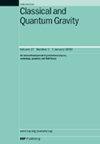将 1064 纳米波长的 30 W 激光转换为 2128 纳米波长的 20 W 激光,并比较相对功率噪声
IF 3.6
3区 物理与天体物理
Q2 ASTRONOMY & ASTROPHYSICS
引用次数: 0
摘要
目前所有的引力波(GW)观测站都使用波长为 1064 nm 的掺钕钇钕石榴石(Nd:YAG)激光器。如果将激光波长改为大约 2 微米,并将目前的室温测试块反射镜换成低温冷却的晶体硅测试块,再加上非晶硅和非晶氮化硅层的反射镜涂层,未来引力波天文台的灵敏度将大大提高。所需的激光功率约为 10 瓦,相对功率噪声(RPN)较低。在这里,我们使用实验室制造的变性光学参量振荡器将高功率 Nd:YAG 激光器的光转换为 2128 nm。输入功率为 30 W,输出功率为 20 W,外部转换效率约为 67%。我们发现,在波长转换过程中,RPN 光谱略有增加。我们的研究成果是在现有低噪声 Nd:YAG 激光器基础上开发 2 µm 左右低噪声光的重要一步。本文章由计算机程序翻译,如有差异,请以英文原文为准。
Conversion of 30 W laser light at 1064 nm to 20 W at 2128 nm and comparison of relative power noise
All current gravitational wave (GW) observatories operate with Nd:YAG lasers with a wavelength of 1064 nm. The sensitivity of future GW observatories could benefit significantly from changing the laser wavelength to approximately 2 µm combined with exchanging the current room temperature test mass mirrors with cryogenically cooled crystalline silicon test masses with mirror coatings from amorphous silicon and amorphous silicon nitride layers. Laser light of the order of ten watts with a low relative power noise (RPN) would be required. Here we use a laboratory-built degenerate optical parametric oscillator to convert the light from a high-power Nd:YAG laser to 2128 nm. With an input power of 30 W, we achieve an output power of 20 W, which corresponds to an external conversion efficiency of approximately 67%. We find that the RPN spectrum marginally increases during the wavelength conversion process. Our result is an important step in the development of low-noise light around 2 µm based on existing low-noise Nd:YAG lasers.
求助全文
通过发布文献求助,成功后即可免费获取论文全文。
去求助
来源期刊

Classical and Quantum Gravity
物理-天文与天体物理
CiteScore
7.00
自引率
8.60%
发文量
301
审稿时长
2-4 weeks
期刊介绍:
Classical and Quantum Gravity is an established journal for physicists, mathematicians and cosmologists in the fields of gravitation and the theory of spacetime. The journal is now the acknowledged world leader in classical relativity and all areas of quantum gravity.
 求助内容:
求助内容: 应助结果提醒方式:
应助结果提醒方式:


